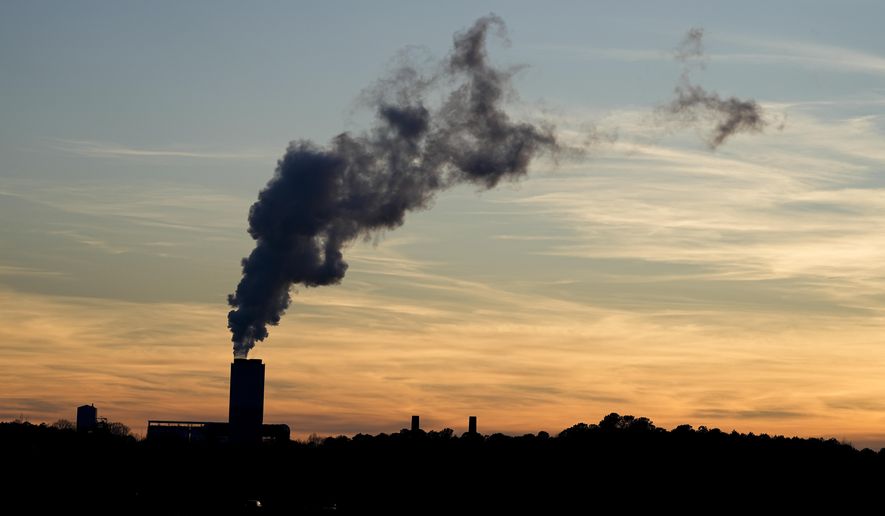The Biden administration finalized rules Thursday requiring new natural gas power plants and existing coal-fired power plants to slash nearly all emissions by 2032, which would shutter plants or significantly reduce operations in the face of increasing U.S. energy demands.
The stringent suite of rules announced by the Environmental Protection Agency is central to President Biden’s climate change agenda to achieve a zero-emission electrical grid by 2035.
Groups opposed to fossil fuels celebrated the rules, but critics in the industry said the restrictions would threaten the stability of the nation’s electricity supply. Rising energy demands have already strained the grid.
“The path outlined by the EPA today is unlawful, unrealistic and unachievable,” said Jim Matheson, CEO of the National Rural Electric Cooperative Association. “It undermines electric reliability and poses grave consequences for an already stressed electric grid.”
Under the standard, existing coal plants and new gas-fired power plants that run more than 40% of the time would have to cut 90% of emissions by 2032.
SEE ALSO: Biden administration scrambles to finalize rules, fearing Trump could undo them
For plants operating at more than 40% capacity, the drastic emissions cap would require nascent carbon capture and storage technologies that have not been successfully implemented in the U.S. or elsewhere.
Natural gas and coal provided nearly 60% of the nation’s electricity in 2023.
The rules are poised to face court challenges. If they are upheld, most of the nation’s coal plants will be unable to meet the stringent emissions standards and will have to shutter. Existing coal plants that agree to close by 2039 can avoid the cap.
In 2023, coal provided more than 16% of the nation’s electricity.
Sen. Joe Manchin III, West Virginia Democrat and chairman of the Energy and Natural Resources Committee, called the rules “death by a thousand cuts to America’s fossil fuel industry, especially coal.”
The rules have been in development for months as the Biden administration pushes to achieve the president’s climate agenda goals — most prominently the elimination of fossil fuels — before the November election.
The president has sought to pivot the nation’s power grid to renewable energy, including wind, solar and nuclear.
In 2023, nuclear power plants provided nearly 19% of U.S. electricity. Wind generation supplied 10.2%, hydropower 5.7% and solar 3.9%. Solar and wind are intermittent and often able to meet only a fraction of the nation’s power demand, which means they must be backed up by either nuclear power or fossil-fuel-generated power to prevent blackouts.
An April 17 report by the Energy Department said the nation’s energy demand is rising and expected to accelerate over the next decade because of expanding manufacturing sectors, data centers and an increasing fleet of electric vehicles.
Officials at the EPA said the “climate and health benefits” of the new emissions rule would substantially outweigh compliance costs and would curtail up to 1,200 premature deaths, 870 hospital and emergency room visits, 360,000 cases of asthma, 48,000 school absences and 57,000 lost workdays by 2035.
The final power plant rules include significant cuts in toxic metal emissions and wastewater pollution from coal-fired plants and a rule for managing the disposal of coal ash, a carcinogen.
It’s the first time the federal government has moved to cut carbon dioxide emissions from existing coal plants.
The EPA said capping emissions for existing coal plants and future electricity plants would prevent 1.38 billion metric tons of carbon pollution through 2047, or the equivalent of annual emissions of 328 million gas-powered cars.
“By developing these standards in a clear, transparent, inclusive manner, EPA is cutting pollution while ensuring that power companies can make smart investments and continue to deliver reliable electricity for all Americans,” EPA Administrator Michael S. Regan said.
The EPA announced a draft proposal in May, but pushback from the energy industry and even from agency staff led to modifications, including excluding the nation’s existing natural gas plants from the emissions rule.
Natural gas provided 43% of the nation’s electricity in 2023.
The EPA plans to draft an emissions rule for existing plants at an unspecified time.
Industry experts say power companies will comply with the rules by building more gas-fired plants. To dodge the emissions cap on new gas-fired power plants, they will operate less than 40% of the time.
“That’s been understood in the industry,” said Jeffrey Holmstead, an energy lobbyist and former EPA assistant administrator. “People are going to build more plants and just run them less often.”
Officials at the EPA initially proposed so-called green hydrogen as a substitute for gas-fired power plants to cut emissions, but they stripped it out of the final rule after critics said the technology isn’t viable at commercial scale.
Mr. Holmstead said some permits have been issued for carbon capture and sequestration technologies but the system is far from operational.
“There’s not a natural gas plant anywhere in the world that uses carbon capture and sequestration,” Mr. Holmstead said.
The new rules, particularly the one capping carbon dioxide emissions, will face legal challenges. Industry experts predict the Supreme Court will ultimately reject the rule.
The Supreme Court ruled in 2022 that only Congress, not the EPA, has the authority to create a system to reduce carbon dioxide emissions from power plants.
To circumvent a new legal challenge, the EPA gave power plants viable options to meet the emissions requirements, including the largely untested carbon capture and sequestration system.
West Virginia Attorney General Patrick Morrisey said the rule is set up to force coal- and natural-gas-fired power plants to close, placing the state’s power grid at risk.
“We will be challenging this rule,” Mr. Morrisey said. “The U.S. Supreme Court has placed significant limits on what the EPA can do. We plan on ensuring that those limits are upheld, and we expect that we will once again prevail in court against this out-of-control agency.”
• Susan Ferrechio can be reached at sferrechio@washingtontimes.com.





Please read our comment policy before commenting.